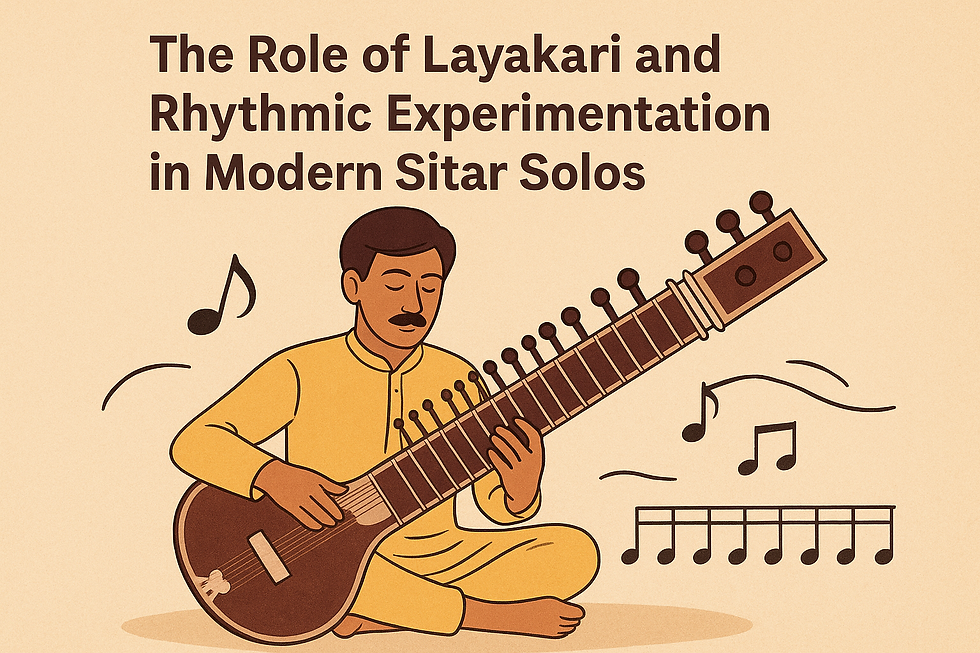Sitar Speedrun: How Layakari Turns You Into a Rhythmic Virtuoso
- Sharanya naidu
- Oct 13
- 3 min read
In the world of Hindustani classical music, the sitar is not just a melodic instrument — it’s a storyteller. And one of the most fascinating ways a sitarist tells their story is through layakari — the art of rhythmic play. For modern sitar players, layakari has become more than just a technical display; it’s a creative language that transforms a performance from skillful to spellbinding.

What is Layakari?
In simple terms, layakari refers to rhythmic variation or manipulation within a fixed tala (rhythmic cycle). It’s the performer’s way of playing with time — stretching, compressing, or weaving through the beats in unexpected patterns, while still staying within the framework of the rhythm.
For example, if the tala is teental (16 beats), a sitarist might experiment by playing phrases in double speed (dugun), triple speed (tigun), or even introducing syncopation and off-beat accents that challenge the listener’s sense of pulse.
🎶 Why Layakari Matters in Sitar Solos
Traditionally, sitar performances focused heavily on melodic elaboration (alap, jod, jhala) and the development of raga. But in modern concert practice, rhythmic exploration has gained prominence. Layakari adds a new layer of excitement, showcasing a musician’s imagination, timing, and mastery over both melody and tala.
Here’s why it’s so essential:
Adds surprise and tension: Layakari keeps the listener engaged by breaking rhythmic expectations.
Shows control and creativity: It highlights the performer’s deep understanding of tala.
Builds energy: As the solo progresses toward the climax (especially in jhala), rhythmic play heightens the musical intensity.
Connects with percussion: It creates a lively conversation between the sitar and tabla, turning the performance into a dialogue rather than a monologue.
🪶 Modern Approaches to Rhythmic Experimentation
Contemporary sitarists have expanded the idea of layakari in innovative ways:
Polyrhythmic Layers: Some performers introduce patterns that superimpose different rhythmic cycles, creating a sense of “time within time.”
Odd-Time Experiments: Beyond traditional 16-beat cycles, modern artists explore unusual talas like Jhaptal (10 beats) or Rupak (7 beats) with intricate layakari.
Cross-genre Rhythms: Fusion artists blend Hindustani rhythms with jazz or world music time signatures, giving the sitar a global rhythmic identity.
Mathematical Precision: Sitarists calculate patterns that resolve exactly on the sam (the first beat), creating thrilling rhythmic puzzles for the listener.
🧠 For the Learner: How to Begin Practicing Layakari
Layakari may seem advanced, but even beginners can start exploring its foundations:
Internalize the tala: Clap, recite, and count the beats mentally while playing.
Start with simple patterns: Try doubling or halving note durations within a fixed beat cycle.
Work with tabla loops: Practicing with a metronome or tabla app helps you feel the groove and identify off-beats.
Listen and imitate: Study performances by masters like Ravi Shankar, Nikhil Banerjee, and Shahid Parvez Khan to hear how they use rhythmic play naturally.
Experiment in jhala: This is where layakari becomes most dynamic — try varying your plucking speed and accents.
🌟 The Beauty of Balance
While rhythmic experimentation can dazzle, the real artistry lies in balance. A great sitarist never lets layakari overshadow the emotional essence of the raga. The interplay of melody and rhythm must feel organic — like a heartbeat that occasionally skips, but always returns to pulse.
🎧 In Essence
Layakari in modern sitar solos represents a conversation between time and creativity. It bridges the traditional and the contemporary, inviting both the performer and listener to experience rhythm not as a fixed boundary but as a living, breathing space for expression.
For today’s sitar learners, mastering layakari isn’t just about counting beats — it’s about learning how to dance with rhythm while keeping the soul of the raga intact.



Comments